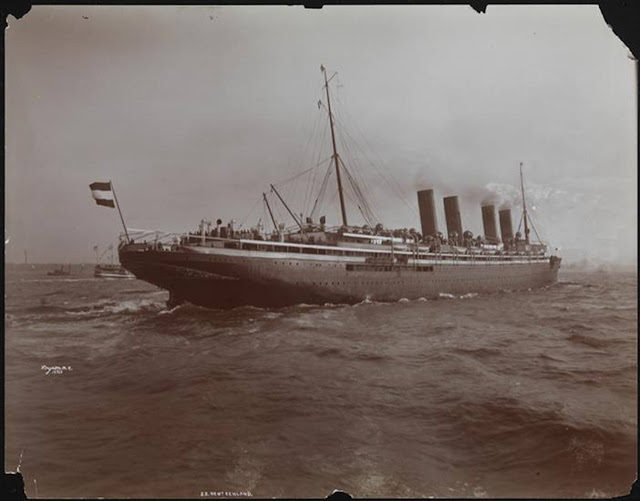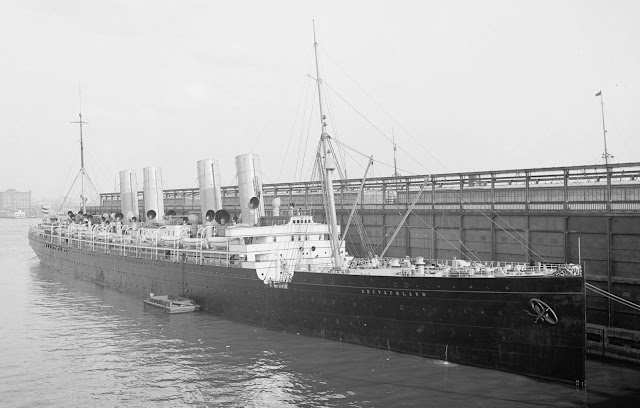The DEUTSCHLAND of
HAPAG was the only four stacker and only German Greyhound from HAMBURG
AMERIKANISCHE PAKETFAHRT AKTIEN GESELLSCHAFT (HAPAG or HAMBURG AMERICA LINE,
which is much more convenient to English tongues).
by João Martins, editing by Earl of Cruise
by João Martins, editing by Earl of Cruise
ss DEUTSCHLAND, 1900, the HAPAG Greyhound and its only four-stacker - © colouring by Daryl LeBlanc
The Blue Riband
holder ss DEUTSCHLAND is known for a number of facts, happenings and stories
around her. Here we will see those João Martins wrote for us about.
The DEUTSCHLAND Incident - A German Prince vs Marconi - by João Martins
Postcard, showcasing the State visit of Prince Heinrich to the United States in 1902 - own collection
In
March 1902 the ship played a major role in what would become known as the DEUTSCHLAND Incident.
ss DEUTSCHALND was carrying Prince Heinrich of Hohenzollern, brother of Kaiser
in Germany Wilhelm II, back to Europe after a highly publicised trip to the United States.
ss DEUTSCHLAND leaving New York after the State visit of His Imperial Highness Prince Heinrich in Germany - all four pictures above are copies of photo slides from the Museum für Hamburgische Kunstgeschichte, Hamburg, Germany
The
ss DEUTSCHLAND departs New York to Hamburg with a very special guest. Prince
Heinrich, brother of Kaiser Wilhelm II, is on board going back home after a successful
trip to the United States.
A
huge number of people turned out for the formal farewell. Plenty of national
flags from both sides. The ship is also flying the German imperial standard.
ss DEUTSCHLAND - picture from a photo slides from the Museum für Hamburgische Kulturgeschichte, Hamburg, Germany
During
this voyage, the ss DEUTSCHLAND was prevented from using its Slaby-d'Arco
system of wireless telegraphy as the Marconi radio stations refused its radio
traffic through their nets and blocked the rival
system.
Prince
Heinrich, who tried to send wireless messages to both Germany and the US, was
outraged.
Marconi
shore stations refused, except in the case of emergency, to accept messages
from ships operating equipment from other sources. This brought up a number of
questions of fairness — competitors claimed the Marconi companies were trying
to set up a worldwide monopoly, while Marconi charged that his competitors were
little more than parasites, wanting to take advantage of the investment his
company had made in setting up the expensive shore stations.
Marconi
would eventually be forced to give access to their stations to other companies.
This incident turned out to be one of the important moments in the early
history of wireless transmission.
ss
DEUTSCHLAND - HAMBURG AMERICA LINE only Four-Stacker - by João Martins
The
ss DEUTSCHLAND was a 16,703 GRT German ocean liner built by AG Vulcan in
Stettin for the HAMBURG AMERICA LINE and completed in 1900. It was HAMBURG AMERICA's first and only four-stacker ship.
ss DEUTSCHLAND at her pier in Manhattan - © Museum für Hamburgische Kunstgeschichte, Hamburg, Germany
The
ss DEUTSCHLAND was HAPAG's answer to the ss KAISER WILHELM DER GROSSE of its
domestic rival the LLOYD. They had watched enviously as their main competitor
took all the glory with the biggest, fastest and most luxurious ship on the
North Atlantic.
ss DEUTSCHLAND advertising, prior to her inauguration, 1899, as DEUTSCHLAND is based on the lines of ss KAISER WILHELM DER GROSSE, the artist is showing in his drawing the lines of the front of the superstructure of the KAISER - © my friend Helmut Cauer, ex PR spokeman of HAPAG LLOYD, from his book FERNWEH AUF SCHIFFSPLAKATEN - Glanzlichter Maritimer Werbegrafik, Koehler Verlagsgesellschaft, Hamburg
They had to build a ship to rival or even outmatch it.
ss DEUTSCHLAND sailing out to New York, off the Steubenhöft in Cuxhaven, Germany - own collection
With
its tonnage and at 207 metres long, the ss DEUTSCHLAND was the biggest vessel
ever built after White Star's rms OCEANIC in 1899, not counting the ss GREAT
EASTERN.
She
followed the ss KAISER WILHELM DER GROSSE trend and sported four funnels divided
in pairs. Her quadruple expansion steam engines connected to two screws gave
her an average speed of 23 knots.
ss
DEUTSCHLAND, Main Dining Room, First Class, picture copy
of a photo slide from the Museum für Hamburgische Kunstgeschichte, Hamburg, Germany
ss DEUTSCHLAND, First Class Drawing Room, picture copy
of a photo slide from the Museum für Hamburgische Kunstgeschichte, Hamburg, Germany
ss DEUTSCHLAND, First Class Ladies Room, picture copy
of a photo slide from the Museum für Hamburgische Kunstgeschichte, Hamburg, Germany
ss DEUTSCHLAND, First Class Staircase, picture copy
of a photo slide from the Museum für Hamburgische Kunstgeschichte, Hamburg, Germany
ss DEUTSCHLAND, First Class Lounge, picture copy
of a photo slide from the Museum für Hamburgische Kunstgeschichte, Hamburg, Germany
She
had accommodation for 450 first class, 300 second class and 1350 third class
passengers. The ship had vast luxurious interiors. The elegant first class café
had a square glass dome in the high ceiling. This room became very popular
among passengers and the first class grill room also proved to be a success.
The board of
HAPAG pressed Albert Ballin, who´s interest was in comfort and luxury for his
guests, ordering this record breaker from the very same shipbuilder, AG VULCAN
in Stettin, where NORDDEUTSCHER LLOYD has ordered his record breaker KAISER
WILHELM DER GROSSE. DEUTSCHLAND was a near sister to the competitor from
Bremen, and for the short time she should be available for HAPAG, an advanced
"copy" of KAISER WILHELM DER GROSSE.
Primarily this
order was caused by the rivalry between the two Hanseatic cities of Hamburg
and Bremen. The public of Hamburg, and the HAPAG board members felt set back
by the brand new LLOYD vessel. It was only a second thought for being international
the prime Transatlantic company with such a ship.
Albert Ballin as
well the board of HAPAG new too well the costs to run and maintain such a
Greyhound - "a big waste on room for the space of the engines",
high coal consumption, further more room to preserve for the coal, and
therefore less space for cargo and passengers, and at least less income ...
What has not been
considered by the board, was the fact, that the international traveling
public nearly jumped on the newest, most luxurious and fastest Transatlantic
boat. This was a fact on both sides of the pond.
And DEUTSCHLAND and
KAISER WILHELM proved to be very popular amoung the travellers. Especially
amoung those who could afford the higher prices for their passage on board of
these German Greyhounds.
On both liners, a
fully booked First Class, did pay the the whole voyage (round trip - Europe
New Yoek - Europe) with only the crossing to New York. Further the revenue
paid the maintenance. In those days ships hadn´t normaly been built on
credits as today, with 12 years, and further up to three times 12 years on
repayment.
Both lines have
made a mail contract for the Transatlantic with DEUTSCHE REICHSPOST. but this
was not a subsidiary as one may think. It covered the costs for the mail
transport and handling - at least a normal cargo contract was with anyx
other shipping contractor. But the liners carrying mail got a prestigeous
adding to their names: REICHSPOST DAMPFER, in short R.P.D.
Each vessel
plowing through the seas has its vibrations. But especially a fast going
vessel, and the more a vessel running at highest speed. And DEUTSCHLAND became
her nickname imprinted by nagging British travellers as the "Cocktail
Shaker". She was troubled by her vibrations, caused by her huge steam
engines and her screws. It was that peculiar, that DEUTSCHLAND on one of her voyages
home, got a broken stern which caused to loose her rudder. Her captain
steered the vessel save back home only with her srews, and permanent order
given to the mashine room ... A masterpiece of seaman ship and engineering!
Addition by
earlofcruise
|
The
ss DEUTSCHLAND departed Hamburg to Plymouth and New York on her maiden voyage on
6 July 1900. She immediately snatched the Blue Riband from her rival. The ss KAISER
WILHELM DER GROSSE proved too powerless to regain the prize and there seemed to
be no ship to threaten the ss Deutschland.
Even
though a luxury liner, the ss DEUTSCHLAND faced a common problem on board speed
champions - vibrations. The rate of vibration at 23 knots was said to be very
disturbing among the passengers.
Also
in 1902, the ss DEUTSCHLAND lost the Blue Riband to the newly commissioned LLOYD
liner ss KRONPRINZ WILHELM. However, she regained it the following year and
kept the East Bound record until the arrival of the British Cunard Line’s rms LUSITANIA
and rms MAURETANIA in 1907.
By
then the HAMBURG AMERICA LINE's management had decided on aiming on size,
stability and luxury only, not speed. By this the ss DEUTSCHLAND was doomed as
a transatlantic liner. Her last voyage to New York was on 24 September 1910.
Afterwards,
she went through a complete refit to become a dedicated luxury cruise ship, the
ss VICTORIA LUISE. Her original engines were derated to 17 knots as a high
service speed was no longer needed. At the same time, the exterior of the ship
was repainted in all white and her passenger capacity was also reduced to only
487 first class passengers.
ss VICTORIA LUISE, ex DEUTSCHLAND, when HAPAG
lost the first purpose built cruise vessel ss PRINCESSIN VICTORIA LUISE off
Jamaica, they have been in need for a new high end cruise vessel and rebuilt
the DEUTSCHLAND - own collection
The
ss DEUTSCHLAND cruised the West Indies, Scandinavia and the Mediterranean as
the finest cruise ship of the time until the oubreak of the First World War.
She
was intended to be converted to an auxiliary cruiser but because of her still
troublesome engines, she remained docked in Hamburg throughout the conflict.
After the end of the war in 1918, she was not surrended to the Allies as many
other major German liners.
ss HANSA, emigration vessel, reconstructed of
ss VICTORIA LUISE, ex DEUTSCHLAND, nothing was left of her former grace and
luxury - own collection
In
1921, the ss VICTORIA LUISE was rebuilt with two funnels and accommodation for
36 first class and 1350 third class passengers. She was renamed ss HANSA and
pressed into the emigrant service. However, the United States passed strict
immigration laws in the early 1920s which significantly reduced the emigrant
trade of shipping companies.
She
arrived at Hamburg from New York for the last time on 25 September 1924. By now
it was evident the ship was old and not fit to match a new generation of ocean
liners.
She
was finally sold for scrap and broken up in Hamburg in 1925.


















Comments
Post a Comment